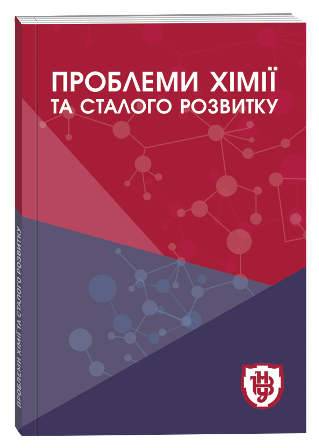METFORMIN-SENSITIVE POTENTIOMETRIC SENSOR
DOI:
https://doi.org/10.32782/pcsd-2022-2-5Keywords:
metformin, tropeolin 00, ionic associate, potentiometric sensor.Abstract
Metformin (N,N-dimethylbiguanidine) in its protonated form as metformin hydrochloride is used worldwide as an advanced antidiabetic drug for type 2 diabetes. Hyperinsulinemia and insulin resistance of cells are the main causes of this disease. For patients with diabetes, metformin hydrochloride (hereinafter – MET) works by improving cell sensitivity to insulin. It has been shown that metformin with tropeolin 00 (T00) forms an ionic associate that can be isolated in solid form and is suitable for the creation of plasticized membrane potentiometric metformin-sensitive sensors. The energy efficiency of ionic associate formation is substantiated by the method of mathematical modeling. Molecular modeling of T00- + MET+ systems and related calculations were performed using the HyperChem 8.0 package for various initial variants of counter ion relative to each other (single point procedure). Geometric optimization of ions was performed by the method of molecular mechanics MM+. The standard enthalpy (ΔH0) of ion formation and the association “MET+ + T00-” was determined by the semi-empirical method PM3. The difference in the energy of formation of the ionic associate and the sum of the energies of formation of its components is 312 kJ/mol. Therefore, the process of ionic associate formation is thermodynamically advantageous. Modeling and optimization of membrane composition is carried out. The results of the study of the influence of the nature of plasticizers on the electroanalytical properties of the developed sensors indicate that the best plasticizer for the system is TCP or DNF. For these solvents, the product of the dielectric constant and Rorschneider polarity (ε × PR) is 123,5 and 175 respectively. For plasticizers that were less effective (DBF and DEF), these values are 235,6 and 326 respectively. For membranes with the same content of plasticizer of one homologous series (DEF, DBF, DOF, DNF), the slope of the Nernst function decreases with increasing dielectric constant of the plasticizer solvent. It is shown that the working pH range of the electrode is from 2 to 11. The drift potential does not exceed 1–3 mV/day. Stable values of electrode potentials are set for 5–15 s. The stability of the electroanalytical characteristics of the optimized membranes can be traced for at least three months. The developed sensors show satisfactory selectivity in relation to a number of substances and ions. The 300 and 1000 times the amount of glucose, starch, polyvinyl alcohol, Na+, K+, Mg2+, Ca2+, Ba2+ ions do not interfere with MET determination. This, in turn, allows the practical use of developed MET-sensitive sensors in a variety of objects. A method of potentiometric determination of metformin has been developed, which has been tested in its determination in dosage forms.
References
García-Sáncez M., Lobaton-Ginsberg M., Ferreira-Hermosillo A. Metformin in Differentiated Thyroid Cancer: Molecular Pathways and Its Clinical Implications. Biomolecules. 2022. Vol. 12. Iss. 4. Р. 574. DOI: 10.3390/biom12040574.
Unique Features of Metformin: A Combined Experimental, Theoretical, and Simulation Study of Its Structure, Dynamics, and Interaction Energetics with DNA Grooves / S. Mondal et al. J. Phys. Chem. B. 2018. Vol. 122. Iss. 8. Р. 2227–2242. DOI: 10.1021/acs.jpcb.7b11928.
Reduction in the incidence of type 2 diabetes with lifestyle intervention or metformin / Diabetes Prevention Program Research Group. N. Engl. J. Med. 2002. Vol. 346. Iss. 6. Р. 393–403. URL: https://jdc.jefferson.edu/medfp/322.
Sequential intensification of metformin treatment in type 2 diabetes with liraglutide followed by randomized addition of basal insulin prompted by A1C targets / J. DeVries et al. Diabetes care. 2012. № 35. Р. 1446–1454. DOI: 10.2337/dc11-1928.
Metformin and reduced risk of cancer in diabetic patients / J. Evans et al. Bmj. 2005. № 330. Р. 1304–1305. DOI: 10.1136/bmj.38415.708634.F7.
Role of AMP-activated protein kinase in mechanism of metformin action / G. Zhou et al. J. Clin. Investig. 2001. № 108. Р. 1167. DOI: 10.1172/JCI13505.
Metformin targets c-MYC oncogene to prevent prostate cancer / T. Akinyeke et al. Carcinogenesis. 2013. № 34. Р. 2823–2832. DOI: 10.1093/carcin/bgt307.
Metformin targets the metabolic Achilles heel of human pancreatic cancer stem cells / E. Lonardo et al. PloS one. 2013. № 8. P. e76518. DOI: 10.1371/journal.pone.0076518.
Metformin targets ovarian cancer stem cells in vitro and in vivo / J. Shank et al. Gynecol. Oncol. 2012. № 127. Р. 390–397. DOI: 10.1016/j.ygyno.2012.07.115.
Garcia A., Tisman G. Metformin, B12, and enhanced breast cancer response to chemotherapy. J. Clin. Oncol. 2009. № 28. P. e19. DOI: 10.1200/JCO.2009.25.7857.
Iliopoulos D., Hirsch H., Struhl K. Metformin decreases the dose of chemotherapy for prolonging tumor remission in mouse xenografts involving multiple cancer cell types. Cancer research. 2011. № 71. Р. 3196–3201. DOI: 10.1158/0008-5472.CAN-10-3471.
Metformin and pathologic complete responses to neoadjuvant chemotherapy in diabetic patients with breast cancer / S. Jiralerspong et al. J. Clin. Oncol. 2009. № 27. Р. 3297–3302. DOI: 10.1200/JCO.2009.19.6410.
Perumalsamy V., Kumar H., Suresh S. Conjugation of Curcumin and Metformin for Improved Pharmacological Profile in Cancer Therapy: An In Silico Approach. Biointerface Research in Applied Chemistry. 2023. Vol. 13. Iss. 2. Р. 101. URL: https://doi.org/10.33263/BRIAC132.101.
Quantifying the effect of metformin treatment and dose on glycemic control / J. Hirst et al. Diabetes Care. 2012. № 35. Р. 446–454. DOI: 10.2337/dc11-1465.
Scheurer M., Sacher F., Brauch H.-J. Occurrence of the antidiabetic drug metformin in sewage and surface waters in Germany. J. Environ. Monit. 2009. № 11. Р. 1608–1613. DOI: 10.1039/b909311g.
Rao C. Biguanides. Encyclopedia of Toxicology / ed. by P. Wexler. 3rd ed. Amsterdam : Academic Press, 2014. Р. 452–455. URL: https://www.elsevier.com/books/encyclopedia-of-toxicology/wexler/978-0-12-386454-3.
UV spectrophotometric method for the quatitation of metformin hyrochloride in pharmaceutical dosage form / P. Saxena et al. Orient. J. Chem. 2010. Vol. 26. Iss. 5. Р. 1553–1556. URL: http://www.orientjchem.org/?p=24645.
Protonation-deprotonation and structural dynamics of antidiabetic drug metformin / B. Hernandez et al. J. Pharm. Biomed. Anal. 2015. № 114. Р. 42–48. DOI: 10.1016/j.jpba.2015.04.041.
Kormosh Zh., Savchuk T. Potentiometric sensor for povidone-iodine determination. Pharm. Chem. J. 2016. Vol. 50. Iss. 8. Р. 556–557. DOI: 10.1007/s11094-016-1489-8.
Design and aplication of levamisole-selective membrane sensor / N. Zubenia et al. Anal. Bioanal. Electrochem. 2016. Vol. 8. Iss. 4. Р. 466–477. URL: http://abechem.ir/No.%204-2016/2016,%208(4),%20466-477.pdf.
Potentiometric membrane sensors for levamisol determination / N. Zubenia et al. Mediter. Journ. Chem. 2016. Vol. 6. Iss. 2. P. 7–14. DOI: 10.13171/mjc61/016111516/kormosh.
Potentimetric sensor for the determination of povidone-iodine / Zh. Kormosh et al. Anal. Bioanal. Electrochem. 2014. Vol. 6. Iss. 3. Р. 367–378. URL: http://abechem.ir/No.%203-2014/2014,6_3_,367-378.pdf.
Design of a Vitamin B1-Selective Electrode Based on an Ion-Pair and Its Application to Pharmaceutical Analysis / I. Antal et al. Electroanalysis. 2010. Vol. 22. Iss. 22. Р. 2714–2719. URL: https://doi.org/10.1002/elan.201000124.
Design of a Gramine-Selective Membrane Sensor / N. Zubenia et al. Anal. Bioanal. Electrochem. 2018. Vol. 10. Iss. 5. Р. 531–540. URL: http://abechem.ir/No.%205-2018/2018,%2010(5),%20531-540.pdf.
Kormosh Zh., Markovska N., Kormosh N. Potentiometric Sensor for Benzylpenicillin Determination. Pharm. Chem. J. 2019. Vol. 53. Р. 577–579. URL: https://doi.org/10.1007/s11094-019-02040-w.
Potentiometric Sensor for Naproxen Determination / Zh. Kormosh et al. Pharm. Chem. J. 2021. Vol. 55. Iss. 1. Р. 97–99. URL: https://doi.org/10.1007/s11094-021-02379-z.
The New Mephenaminate- and Phenylanthranilate- Selective Membrane Sensor / Zh. Kormosh et al. Anal. Bioanal. Electrochem. 2022. Vol. 14. Iss. 1. Р. 32–44. URL: http://www.abechem.com/article_249321.html.
Potentiometric Sensor for Ketoprofen Determination / Zh. Kormosh et al. Pharm. Chem. J. 2022. Vol. 55. Iss. 1. Р. 1412–1415. DOI: 10.1007/s11094-022-02590-6.
Khaled E., Kamel M. Cyclodextrin-Based Potentiometric Sensors for Metformin. Sensing in Electroanalysis / K. Kalcher, R. Metelka, I. Švancara, K. Vytas (eds.). Pardubice : University Press Centre, 2011. Р. 323–335. URL: https:// dk.upce.cz/bitstream/handle/10195/42526/KhaledE_Cyclodextrin-Based_2011.pdf?sequence=1.
Novel Metformin Carbon Paste and PVC Electrodes / K. Elmorsy et al. Current Pharm. Anal. 2007. № 3. Р. 262–267. DOI: 10.2174/157341207782418776.
Miniaturized ionophore-based potentiometric sensors for the flow-injection determination of metformin in pharmaceutical formulations and biological fluids / E. Khaled et al. Analyst. 2012. Vol. 23. Iss. 137. Р. 5680–5687. DOI: 10.1039/C2AN35696A.







